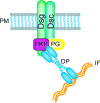Desmosome regulation and signaling in disease
- PMID: 25693896
- PMCID: PMC4489137
- DOI: 10.1007/s00441-015-2136-5
Desmosome regulation and signaling in disease
Abstract
Desmosomes are cell-cell adhesive organelles with a well-known role in forming strong intercellular adhesion during embryogenesis and in adult tissues subject to mechanical stress, such as the heart and skin. More recently, desmosome components have also emerged as cell signaling regulators. Loss of expression or interference with the function of desmosome molecules results in diseases of the heart and skin and contributes to cancer progression. However, the underlying molecular mechanisms that result in inherited and acquired disorders remain poorly understood. To address this question, researchers are directing their studies towards determining the functions that occur inside and outside of the junctions and the extent to which functions are adhesion-dependent or independent. This review focuses on recent discoveries that provide insights into the role of desmosomes and desmosome components in cell signaling and disease; wherever possible, we address molecular functions within and outside of the adhesive structure.
Figures
References
-
- Aceto N, Bardia A, Miyamoto DT, Donaldson MC, Wittner BS, Spencer JA, Yu M, Pely A, Engstrom A, Zhu H, Brannigan BW, Kapur R, Stott SL, Shioda T, Ramaswamy S, Ting DT, Lin CP, Toner M, Haber DA, Maheswaran S. Circulating tumor cell clusters are oligoclonal precursors of breast cancer metastasis. Cell. 2014;158:1110–1122. - PMC - PubMed
-
- Aktary Z, Chapman K, Lam L, Lo A, Ji C, Graham K, Cook L, Li L, Mackey JR, Pasdar M. Plakoglobin interacts with and increases the protein levels of metastasis suppressor Nm23-H2 and regulates the expression of Nm23-H1. Oncogene. 2010;29:2118–2129. - PubMed
-
- Aktary Z, Kulak S, Mackey J, Jahroudi N, Pasdar M. Plakoglobin interacts with the transcription factor p53 and regulates the expression of 14-3-3sigma. J Cell Sci. 2013;126:3031–3042. - PubMed
Publication types
MeSH terms
Substances
Grants and funding
- R01-CA122151/CA/NCI NIH HHS/United States
- T32-AR060710/AR/NIAMS NIH HHS/United States
- R01-AR062110/AR/NIAMS NIH HHS/United States
- R01 AR043380/AR/NIAMS NIH HHS/United States
- R01 AR062110/AR/NIAMS NIH HHS/United States
- P30 CA060553/CA/NCI NIH HHS/United States
- R01-AR041836/AR/NIAMS NIH HHS/United States
- R01 AR041836/AR/NIAMS NIH HHS/United States
- T32 AR060710/AR/NIAMS NIH HHS/United States
- P30-AR057216/AR/NIAMS NIH HHS/United States
- P30 AR075049/AR/NIAMS NIH HHS/United States
- P30 AR057216/AR/NIAMS NIH HHS/United States
- R37 AR043380/AR/NIAMS NIH HHS/United States
- R37-AR043380/AR/NIAMS NIH HHS/United States
- R01 CA122151/CA/NCI NIH HHS/United States
LinkOut - more resources
Full Text Sources
Other Literature Sources


